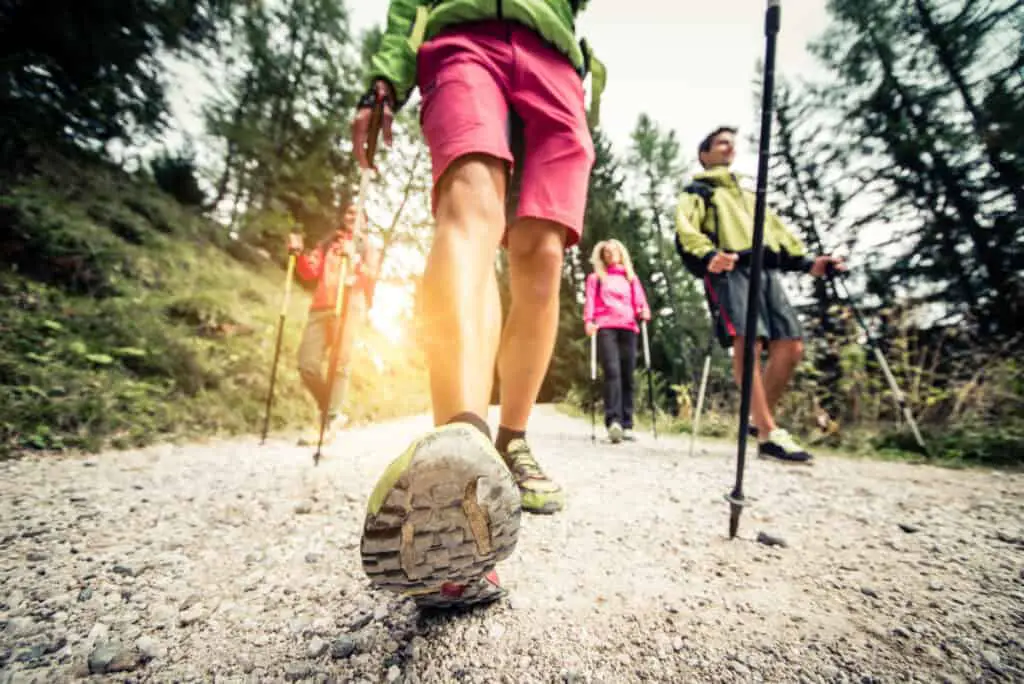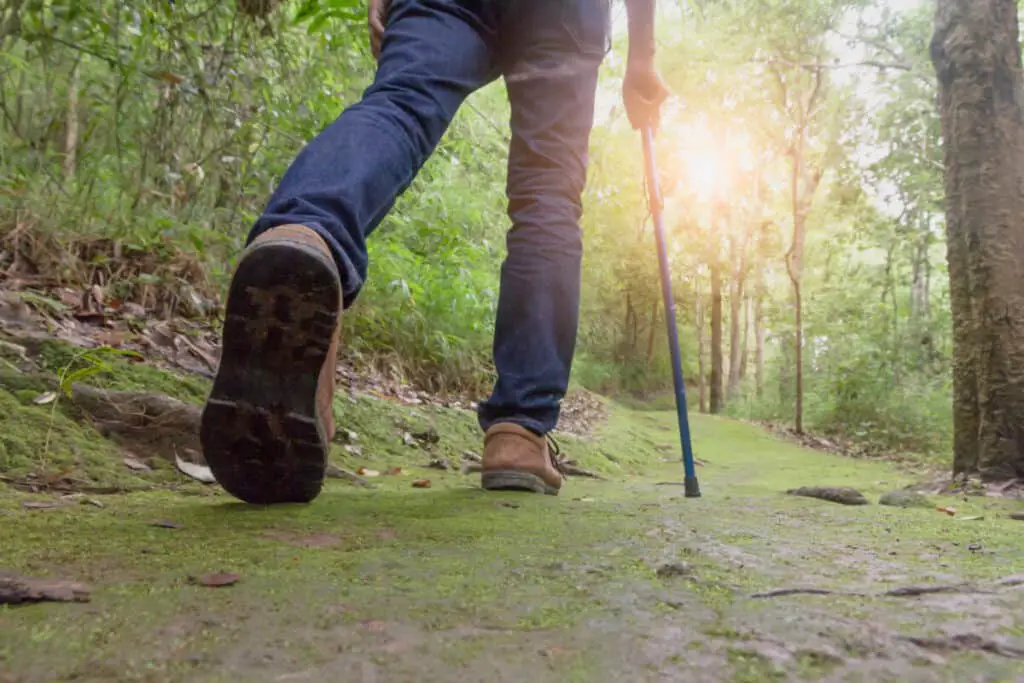
Hiking is a popular pastime for many people, but those who suffer from knee pain or want to avoid damaging their knees wonder if the activity is right for them. Is hiking bad for your knees, and what can you do to lessen the potential damage?
Hiking downhill can damage the joint and surrounding cartilage in the knees. However, hikers can take precautions to prevent such damage. Though hiking can cause damage to the knees, it also strengthens the muscles surrounding it, therefore, providing more support.
Now that you know that hiking can strengthen your knees, you are likely wondering if it can help reduce knee pain and what you can do to improve your hiking technique to avoid knee damage. Keep reading to find out.
Go Hiking Regularly
If you want to reduce the amount of pain you feel while hiking, go regularly. The regular hikes will strengthen the muscles that surround your knee and throughout your legs. Go hiking at least once a week, and go more often as your body acclimates to the exercise.
As the muscles around your knee strengthen, your knees will be less susceptible to damage. If you suffer from knee pain, it will eventually lessen as the muscles strengthen and the support for your knee increases with them.
If you have issues with knee pain or have suffered from a knee injury in the past, you may have to wear a supportive knee brace for the first few months. Consult your doctor to see how long you should wear a knee brace during your hikes.
Though hiking more often can help relieve knee pain, hiking frequently can cause a condition referred to as “hiker’s knee.” Unfortunately, hiker’s knee requires you to stop hiking immediately. It typically only occurs after several hours of consecutive hiking. If you have pain around your knee cap, stop hiking as soon as possible and visit the doctor.
When hiking, drink plenty of water before, during, and after. Hiking can be an intense exercise, causing you to sweat. Drink plenty of water to avoid dehydration while hiking. Consider purchasing a water bottle with a sling-like strap, so you don’t have to carry one in your hand.
When you begin hiking regularly, you will likely become tired quickly. Take as many breaks as you need. Over-exhausting yourself will not be beneficial in any way. Take breaks on the side of the trail, out of the way of other hikers.
Use Proper Equipment
When hiking, use the proper equipment, especially when avoiding knee damage.
Use the Following Equipment when Hiking to Avoid Knee Damage
- Trekking Poles
- A Knee Brace
- Kinesio Tape
Trekking poles are long poles that you hold in each hand. They help people walk long distances without becoming exhausted. However, they also reduce the amount of weight on your knee. With less weight to support your knees don’t have to work as hard. You might not feel like the trekking poles make a difference; however, they can drastically decrease wear and tear on your knees.
Not only do trekking poles reduce the weight on your joints, but they also decrease the amount of pressure they are under. Additionally, trekking poles improve your balance. This reduces your chances of tripping and potentially getting hurt while walking across uneven terrain. When hiking with trekking poles, you engage more muscles than just those in your legs. Because you have to lift the poles, this tool helps you build muscles in your arms and legs.
Another method to avoid damaging your knees during a hike is wearing a knee brace or Kinesio tape. These items provide extra support for your knees, ensuring that you can go on hikes for years to come. If you have had a knee injury in the past, you will likely need to wear a knee brace or Kinesio tape whenever you go hiking. Unfortunately, after one knee injury, the risk of another is high, regardless of your experience and the precautions you take.
If you want to learn more about how trekking poles reduces the potential for injuries while hiking or walking long distances, read this study found in the National Library of Medicine database.
found in the National Library of Medicine database.
Wear Proper Footwear

Wearing proper footwear is one of the easiest things you can do to protect your knees while hiking. Many people think that they can just wear regular sneakers and be completely comfortable; however, hiking boots are the better choice of footwear.
Wearing the right shoes help protect your knees because they reduce the impact from the ground. Have you ever noticed that your knees don’t hurt very much after a run if you wear running shoes that have plenty of support? The same is true for hiking boots.
Wear hiking boots that fit well and feel comfortable, but don’t wear loose hiking boots, or you will get blisters on your feet and the impact of your steps will still hurt your knees. Break-in new hiking boots before you go on a long hike.
Are all the hiking boots in your size too uncomfortable to wear? Do your hiking boots need more arch support? You can remedy both of these problems by purchasing gel inserts. Some doctors will even prescribe custom orthotics to put in your shoes. You will need to get hiking boots that are slightly loose and add the gel inserts to them. If you purchase hiking boots that fit perfectly without the inserts, they may become too tight with them.
Invest in high-quality hiking boots. Expensive hiking boots last longer than low-quality hiking boots and provide more support. Additionally, more expensive hiking boots typically have thicker, shock-absorbing soles. When picking hiking boots, look for a pair with ample ankle support. If your ankle is well-supported, so are your knees. Shoes with ankle support will prevent rolled ankles as well. Hiking boots that go over the ankle also prevent sticks, rocks, and debris from getting into your shoe.
You can also wear compression socks while you are hiking. Compression socks promote blood flow, especially in your lower legs, and reduce knee damage and pain for frequent hikers.
Apply Ice After Hike
After enduring the impact of a hike, your knees need time to rest and rejuvenate afterward. After hiking, chances are your knees will be slightly swollen. When you get home, reduce inflammation and pain by icing your knees. Use an ice pack or get a plastic bag, fill it with ice, and wrap it in a towel before you put it on top of your knee.
In addition to reducing swelling, icing your knees can alleviate any pain you may be experiencing as well. Some hikers find it helpful to apply a light heat source to their knees after a hike. Apply heat to your knees with a heating pad or a hot water bottle.
If you want to avoid knee swelling, only hike on semi-level surfaces that are paved or made of gravel or soil. Unfortunately, that rules out pretty much every hike on earth. If you plan on hiking, prepare for some occasional knee swelling. However, you can start on easier surfaces, acclimating your knees before attempting any rougher trails.
Avoid Hiking Downhill and Don’t Lock Your Knees
If you want to avoid damaging your knees on a hike, avoid hiking straight downhill. Instead, hike on trails that have gradual inclines and declines. When hiking downhill, don’t lock your knees, especially when the hill is steep. Keep them slightly flexed instead.
If you don’t keep your knees slightly bent and flexed while you walk downhill, your knees will absorb all of the impact of each step.
Walk downhill slowly so you can better control where you step and lessen the total impact of your steps on your knees. The faster you walk, the more force you put on your knees. Therefore, the faster you walk, your knees will endure more damage. This is especially the case if you lock your knees.
When walking downhill, take long strides rather than short ones. This will reduce the number of steps you need to take to get to the bottom of the hill and help keep your knees in tip-top shape.
Change Diet
Changing your diet to include Omega-3s will help prevent your knees from becoming damaged from hiking. If you only go hiking once in a while, you may not want to change your diet. However, in preparation for the occasional hike, eat foods high in Omega-3s.
Foods you should consume before hiking:
- Salmon
- Walnuts
- Olive Oil
- Flaxseeds
- Chia seeds
- Soybean Oil
- Canola Oil
- Yogurt
- Eggs
The Omega-3 fatty acids will lubricate your joints, allowing them to move easier while hiking. If your joints are lubricated they will experience less friction during the hike. Omega-3 foods can alleviate pain around your knees, hips, elbows, and shoulders while hiking. It will especially help preserve your knees and reduce knee pain.
Change the Way You Walk
To reduce the knee pain you feel after a hike and to reduce knee damage, change the way you walk during a hike. You might think this is a silly technique, but the way you walk can drastically change your hiking performance.
Take shorter steps than you usually do, unless you are walking downhill, and position your torso over your hips. Avoid leaning forward or backward, even when you are walking uphill or downhill. This will keep you balanced and reduce the strain on your knees, which will help them last longer and reduce damage.
Keep your foot flat on the ground and avoid walking your toes. It is also important to keep your knees and shins vertical to the ground when you are walking up a hill. This may feel odd at first, but after a few hikes, it will feel natural. Walking with this technique focuses the movement on your calves rather than your quads, the muscle most associated with knee problems.
Warm-Up Beforehand and Complete Exercises

If you want to avoid knee damage and enjoy hiking, strengthen your legs and stretch well before going on a hike. Stretch your hamstrings, thighs, and calves.
You will also need to strengthen your leg muscles when you are not hiking. You can strengthen your leg muscles by doing squats and using the stair master at the gym. You can also use a stationary bike. Any exercise that focuses on your legs will benefit you when you start hiking again.
If you stretch and warm-up well before a hike, your muscles will be more pliable and flexible, which will reduce the direct impact your knees have to deal with, so they won’t become damaged. Stretch before and after you go on a hike so you don’t have sore muscles.
Stretching after a hike is more important than just avoiding soreness. While on the hike, you muscles and tendons become very limber. However, when you finish the hike, those same muscles and tendons start to tense up. If you do not stretch them, this will create excessive knee pain.
Avoid Carrying Heavy Items
Avoid carrying heavy items during a hike if you want to avoid injuring your knees. Your knees and hips hold most of your body weight. If you wear a heavy backpack your knees and hips have to hold more weight than normal and will become damaged over time.
It is nearly impossible to avoid bringing a backpack on a hike. However, try your best to only bring the essentials. Use a backpack that is made of lightweight, water-proof materials. The smaller and lighter your pack is, the less weight your knees will have to hold and the less damage they will endure.
If you do have to carry a heavy pack or camping gear while hiking, use trekking poles as they will distribute the weight to your arms so your knees don’t have to support all of your weight.
Yes, it is possible for hiking to cause knee damage; however, hiking is an excellent exercise for strengthening the knees. With the proper precautions and equipment, you can make your hikes much more enjoyable.


